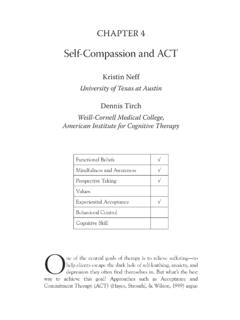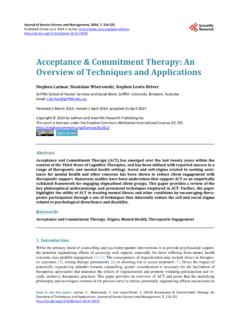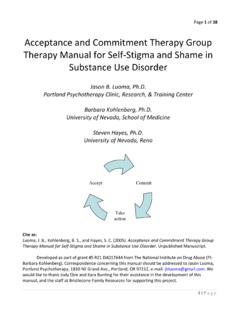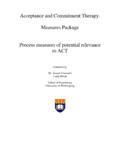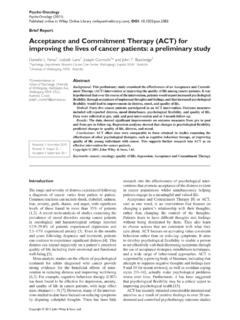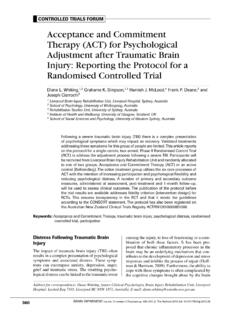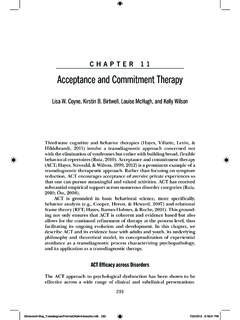Transcription of Acceptance and Commitment Therapy for Anxiety …
1 Acceptance and Commitment Therapy for Anxiety disorders : three CaseStudies exemplifying a unified treatment ProtocolGeorg H. Eifert,Chapman UniversityJohn P. Forsyth,SUNY AlbanyJoanna Arch, Emmanuel Espejo, Melody Keller, and David Langer,UCLAA cceptance and Commitment Therapy (ACT) is an innovative Acceptance -based behavior Therapy that has been applied broadly andsuccessfully to treat a variety of clinical problems, including the Anxiety disorders . Throughout treatment ACT balances Acceptance andmindfulness processes with Commitment and behavior change processes. As applied to Anxiety disorders , ACT seeks to undermineexcessive struggle with Anxiety and experiential avoidance attempts to down-regulate and control unwanted private events (thoughts,images, bodily sensations).
2 The goal is to foster more flexible and mindful ways of relating to Anxiety so individuals can pursue life goalsimportant to them. This article describes in some detail a unified ACT protocol that can be adapted for use with persons presenting withany of the major Anxiety disorders . To exemplify this approach, we present pre- and posttreatment data from three individuals withdifferent Anxiety disorders who underwent treatment over a 12-week period. The results showed positive pre- to posttreatment changes inACT-relevant process measures ( , reductions in experiential avoidance, increases in Acceptance and mindfulness skills), increases inquality of life, as well as significant reductions in traditional Anxiety and distress measures.
3 All three clients reported maintaining orimproving on their posttreatment level of last 40 years, behavior Therapy has led thedevelopment of empirically derived and time-limited behavioral and cognitive-behavioral interventionsto assist those suffering from Anxiety and fear-relatedproblems (Barlow, 2002; Beck, Emery, & Greenberg,1985). This work continues in earnest, as researchers andpractitioners work to improve the potency, durability, andeffectiveness of such interventions. Gaining knowledge ofmechanisms and processes that mediate positive out-comes continues to receive research attention as the past decade, part of this effort has focused onexploring mindfulness and Acceptance -based its most basic form, mindfulness is about focusing ourattention on the present moment and making directcontact with our present experiences, with acceptanceand without defense, and with as little judgment aspossible (Kabat-Zinn, 1994).
4 This work has led to innovative experimental andapplied applications for a wide range of psychopathology(Hayes, Follette, & Linehan, 2004), including Anxiety (Hayes, 1987; Orsillo, Roemer, Block-Lerner, LeJeune, &Herbert, 2005)anddepression(Segal, Williams, &Teasdale, 2002). Acceptance and Commitment Therapy (ACT;Hayes, Strosahl, & Wilson, 1999) is part of thisnewer line of exploration, and studies have shown thatACT can be effective for the treatment of generalizedanxiety disorder (Roemer, Orsillo, & Salters-Pedneault,2008), obsessive-compulsive disorder (Twohig, Hayes, &Masuda, 2006), and posttraumatic stress disorder (Orsillo& Batten, 2005). Our purpose here is to describe anintegrated application of ACT that can be adapted foruse with any of the major Anxiety disorders (Eifert &Forsyth, 2005), including outcome data from threeclients with different Anxiety disorder diagnoses.
5 Indoing so, we wish to point out that what follows is justone of several ways (nottheway) that ACT may beapplied to persons suffering from Anxiety has two major goals: (a) fostering Acceptance ofproblematic unhelpful thoughts and feelings that cannotand perhaps need not be controlled, and (b) commit-ment and action toward living a life according to one'schosen values. This is why ACT is about acceptanceanditis about change at the same time. Applied to anxietydisorders, clients learn to end the struggle with theiranxiety-related discomfortandtake charge by engaging inactions that move them closer to their chosen life goals( values ). Instead of teaching more, different, better strategies to change or reduce unwanted thoughts andfeelings, ACT teaches clients skills to acknowledge andobserve unpleasant thoughts and feelings just as they 385$ 2009 Association for Behavioral and Cognitive by Elsevier Ltd.
6 All rights online at and Behavioral Practice 16 (2009) 368 385 This less avoidant and more flexible way of responding toanxiety and other forms of emotional discomfort creates aspace for individuals to act in ways that move them in thedirection of chosen life goals even when unpleasantthoughts, feelings, and bodily sensations are ACT approach to Anxiety disorders is predicated onthe notion that Anxiety disorders are characterized byexperiential and emotional avoidance, defined as atendency to engage in behaviors to alter the frequency,duration, or form of unwanted private events ( ,thoughts, feelings, physiological events, and memories)and the situations that occasion them when suchavoidance leads to problems in functioning (Hayeset al.)
7 , 1999). The function of experiential avoidance isto control or minimize the impact of aversive internalexperiences. Experiential avoidance can produceimmediate, short-term relief from negatively evaluatedanxiety-related thoughts and emotions, which negativelyreinforces such behavior. It becomes problematic when itinterferes with a person's everyday functioning and life-goal attainment. As described in more detail elsewhere(Eifert & Forsyth, 2005; Forsyth, Eifert, & Barrios, 2006),rigid and inflexible down-regulation of emotions andpatterns of emotional and experiential avoidance isthought to function as a core psychological diathesisunderlying the development and maintenance of severalforms of psychopathology (Blackledge & Hayes, 2001;Hayes, Wilson, Gifford, Follette, & Strosahl, 1996;Kashdan, Barrios, Forsyth, & Steger, 2006), including allanxiety disorders and depression (Barlow, Allen, &Choate, 2004).
8 For instance, Karekla, Forsyth, and Kelly(2004)found that emotional avoidance was morepredictive of panic responses than other psychologicalrisk factors for panic such as Anxiety sensitivity, even inhealthy individuals. This avoidance of discomfort is linkedwith language processes ( , entanglement in one's ownjudgments and evaluations), rule-governed patterns ofaction and inaction ( , I might get anxious in thatunfamiliar situation, so I'd better not go ), and negativeself-evaluations ( , I am worthless or I am incompe-tent ). Such avoidance is problematic because it occurs inthe context of competing approach contingencies, that is,actions that clients wish to engage in as part of a goodquality of life, and in that context the avoidance behaviortends to dominate over approach behavior.
9 This is whyexperiential avoidance is one of the most importanttreatment targets in posture of experiential Acceptance , by contrast,qinvolvesexperiencing events fully and without making contact with the automatic or directstimulus functions of events, without acting to reduce ormanipulate those functions, and without acting on thebasis solely of their derived verbal functionsq(Hayes, 1994,p. 30). Acceptance , unlike experiential avoidance, reflectsan openness to all types of experience (both aversive andpleasant) and a Commitment to abandon the changeagenda where it does not work well and thereby has anegative impact on functioning and only serves toincrease distress, namely, in the realm of private events(Marx & Sloan, 2004).
10 Several independent lines ofresearch (for an extensive review, seeHayes, Luoma,Bond, Masuda, & Lillis, 2006) support the notion thatrigid and inflexible ( , context insensitive) attempts tosuppress and control unwanted private events are largelyineffective, and can result in more (not less) unwantedthoughts and emotions (Koster, Rassin, Crombez, &N ring, 2003; Purdon, 1999), increase distress and restricteffective life functioning (Marx & Sloan, 2004), andreduce engagement in meaningful and valued lifeactivities with a concomitant poorer overall quality oflife (Dahl, Wilson, & Nilsson, 2004; Hayes et al., 2006).Other related lines of work have shown that avoidantcoping strategies such as denial, mental disengagement,and substance abuse predicted more frequent and intenseCO2-induced physical and cognitive panic symptoms thanacceptance-based coping strategies (Feldner, Zvolensky,Eifert, & Spira, 2003; Spira, Zvolensky, Eifert, & Feldner,2004).
